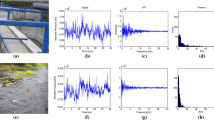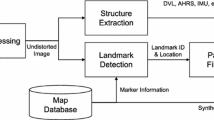Abstract
Underwater robots conventionally use vision and sonar sensors for autonomous localization. Fish on the other hand also have the ability to sense flow, which assists them in navigating. Recently, it has been shown that bioinspired flow sensing can be used in robotics, for tasks such as object detection and positioning in laboratory conditions. In this paper we present a map-based localization technique using flow sensing. The technique is based upon compact histogram features that are extracted from frequency spectra of pressure data acquired using a single piezo-resistive sensor. The features are used to create flow-based map of an underwater environment, and later during an off-line localization phase, similar features are again extracted and used inside a particle filter in order to perform localization. Experiments carried out using pressure data acquired inside a model fish pass validate the proposed technique.
















Similar content being viewed by others
Explore related subjects
Discover the latest articles, news and stories from top researchers in related subjects.Notes
Global Positioning System.
For the same motion command, motion noises of 35 and 50 % (as used in later experiments) would correspond to Gaussian noise with standard deviation of 10 and 14.5 cm, respectively, centered around 50 cm.
References
Akanyeti, O., Chambers, L., Jezov, J., Brown, J., Venturelli, R., Kruusmaa, M., et al. (2013). Self-motion effects on hydrodynamic pressure sensing: Part I. Forward-backward motion. Bioinsperation and Biomimetics, 8, 026001.
Angeli, A., Filliat, D., Doncieux, S., & Meyer, J. A. (2008). Fast and incremental method for loop-closure detection using bags of visual words. IEEE Transactions on Robotics, 24(5), 1027–1037.
Bingham, B., & Seering, W. (2006). Hypothesis grids: Improving long baseline navigation for autonomous underwater vehicles. IEEE Journal of Oceanic Engineering, 31(1), 209–218.
Carreras, M., Ridao, P., Garcia, R., & Nicosevici, T. (2003). Vision-based localization of an underwater robot in a structured environment. In IEEE international conference on robotics and automation, Taipei, Taiwan.
Cha, S. H. (2008). Taxonomy of nominal type histogram distance measures. In American conference on applied mathematics, World Scientific and Engineering Academy and Society (WSEAS) (pp 325–330).
Chen, L., Wang, S., McDonald-Maier, K., & Hu, H. (2013). Towards autonomous localization and mapping of auvs: A survey. International Journal of Intelligent Unmanned Systems, 2, 97–120.
Chen, N., Tucker, C., Engel, J. M., Yang, Y., Pandya, S., & Liu, C. (2007). Design and characterization of artificial hair sensor for flow sensing with ultrahigh velocity and angular sensivity. Journal of Microelectromechanical Systems, 16, 999–1014.
Corke, P., Detweiler, C., Dunbabin, M., Hamilton, M., Rus, D., & Vasilescu, I. (2007). Experiments with underwater robot localization and tracking. In IEEE International conference on robotics and automation, Rome, Italy.
Dagamesh, A. M. K., Bruinink, C., Droodendink, H., Wiegerink, R. J., Lammerink, T. S. J., & Krijnen, G. J. M. (2010). Engineering of biomimetic hair-flow sensor arrays dedicated to high-resolution flow field measurements. In IEEE sensors.
Eskinja, Z., Fabekovic, Z., & Vukic, Z. (2007). Localization of autonomous underwater vehicles by sonar image processing. In International symposium ELMAR, Zadar, Croatia.
Fernandez, V. I., Maertens, A., Yaul, F. M., Dahl, J., Lang, J. H., & Triantafyllou, M. S. (2011). Lateral-line-inspired sensor arrays for navigation and object identification. Marine Technology Society Journal, 45, 130–146.
Forouher, D., Hartmann, J., Litza, M., & Maehle, E. (2011). Sonar-based fastslam in an underwater environment using walls as features. In 15th international conference on advanced robotics (pp. 588–593).
Gao, A., & Triantafyllou, M. (2012). Bio-inspired pressure sensing for active yaw control of underwater vehicles. In Oceans.
Jakuba, M. V., Roman, C. N., Singh, H., Murphy, C., Kunz, C., Willis, C., et al. (2008). Long-baseline acoustic navigation for under-ice autonomous underwater vehicle operations. Journal of Field Robotics, 25, 861–879.
Jezov, J., Akanyeti, O., Chambers, L. D., & Kruusmaa, M. (2012). Sensing oscilations in unsteady flow for better robotic swimming efficiency. In IEEE international conference on systems, man, and cypernatics, Seoul, Korea.
Kottapalli, A. G. P., Asadina, M., Miao, J. M., Barbastathis, G., & Triantafyllou, M. S. (2012). A flexible liquid crystal polymer mems pressure sensor array for fish-like underwater sensing. Smart Materials and Structures, 21, 115030.
Lagor, F. D., DeVries, L. D., Waychoff, K. M., & Paley, D. A. (2013). Bio-inspired flow sensing and control: Atutonomous underwater navigation using distributed pressure measurements. In 18th international symposium on unmanned untethered submersible technology, Portsmouth, NH.
Mallios, A., Ribas, D., & Ridao, P. (2009). Localization advances in the unstructured underwater environment. In Proceedings of the 9th hellenic symposium of oceanography and fishery (pp. 111–116).
Matos, A., Cruz, N., Martins, A., & Pereira, F. L. (1999). Development and implementation of a low-cost lbl navigation system for an auv. In IEEE Oceans, Seattle, WA.
Mogdans, J., & Bleckmann, H. (2012). Coping with flow: Behavior, neurophysiology and modeling of the fish lateral line system. Biological Cybernetics, 106(11–12), 627–642.
Muhammad, N., Strokina, N., Toming, G., Tuhtan, J., Kamarainen, J. K., & Kruusmaa, M. (2015). Flow feature extraction for underwater localization: preliminary results. In IEEE international conference on robotics and automation, Seattle, Washington.
Paull, L., Saeedi, S., Seto, M., & Li, H. (2014). Auv navigation and localization: A review. IEEE Jounal of Ocean Engineering, 39, 131–149.
Peleshanko, S., Julian, M. D., Ornatska, M., McConney, M. E., LeMieux, M. C., Chen, N., et al. (2007). Hydrogel-encapsulated microfabricated hair mimicking fish cupula neuromast. Advanced Materials, 19, 2903–2909.
Plueddemann, A. J., Kukulya, A. L., Stokey, R., & Freitag, L. (2012). Autonomous underwater vehicle operations beneath coastal sea ice. IEEE/ASME Transactions on Mechatronics, 17(1), 54–64.
Qualtieri, A., Rizzi, F., Epifani, G., Ernits, A., Kruusmaa, M., & Vittorio, M. D. (2012). Parylene-coated bioinspired artificial hair cell for liquid flow sensing. Microelectronic Engineering, 98, 516–519.
Ridao, P., Carreras, M., Ribas, D., & Garcia, R. (2010). Visual inspection of hydroelectric dams using an autonomous underwater vehicle. Journal of Field Robotics, 27, 759–778.
Salumae, T., & Kruusmaa, M. (2013). Flow-relative control of an underwater robot. Proceedings of the Royal Society A, 469, 1–19.
Salumae, T., Rano, I., Akanyeti, O., & Kruusmaa, M. (2012). Against the flow: A braitenberg controller for a fish robot. In International conference on robotics and automation, Saint Paul, MN.
Strokina, N., Kamarainen, J. K., Tuhtan, J., Fuentes-Prez, J., & Kruusmaa, M. (2015). Joint estimation of bulk flow velocity and angle using a lateral line probe. IEEE Transactions on Instrumentation and Measurements (accepted to appear).
Thrun, S., Fox, D., Burgard, W., & Dellaert, F. (2001). Robust monte carlo lozalization for mobile robots. Artificial Intelligence, 128, 99–141.
Venturelli, R., Akanyeti, O., Visentin, F., Jezov, J., Chambers, L., Toming, G., et al. (2012). Hydrodynamic pressure sensing with an artificial lateral line in steady and unsteady flows. Bioinsperation and Biomimetrics, 7, 036004.
Watanabe, Y., Ochi, H., Shimura, T., & Hattori, T. (2009). A tracking of auv with integration of ssbl acoustic positioning and transmitted ins data. In OCEANS 2009—EUROPE.
Yun, X., Bachmann, E. R., McGhee, R. B., Whalen, R. H., Roberts, R. L., Knapp, R. G., et al. (1999). Testing and evaluation of an integrated GPS/INS system for small AUV navigation. IEEE Jounal of Ocean Engineering, 24, 396–404.
Zhang, P., Milios, E. E., & Gu, J. (2004). Underwater robot localization using artificial visual landmarks. In IEEE international conference on robotics and biomimetics.
Acknowledgments
This work has been funded by the project FISHVIEW, that has received funding from BONUS, the joint Baltic Sea research and development programme (Art 185), funded jointly from the European Unions Seventh Programme, Keskkonnainvesteeringute Keskus (Estonia), Forschungszentrum Jlich Beteiligungsgesellschaft mbH (Germany) and Academy of Finland.
Author information
Authors and Affiliations
Corresponding author
Electronic supplementary material
Below is the link to the electronic supplementary material.
Rights and permissions
About this article
Cite this article
Muhammad, N., Toming, G., Tuhtan, J.A. et al. Underwater map-based localization using flow features. Auton Robot 41, 417–436 (2017). https://doi.org/10.1007/s10514-016-9558-0
Received:
Accepted:
Published:
Issue Date:
DOI: https://doi.org/10.1007/s10514-016-9558-0




